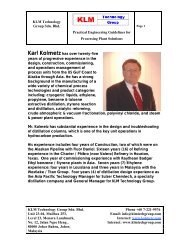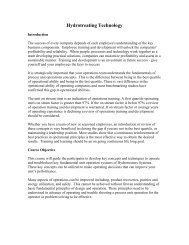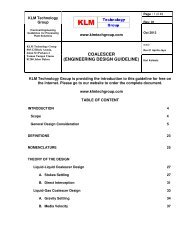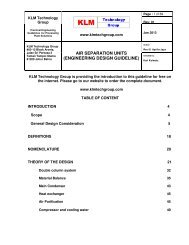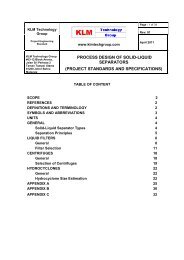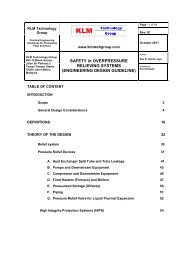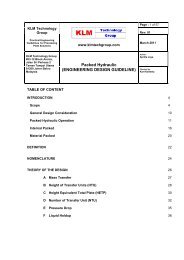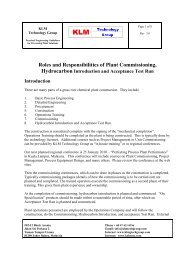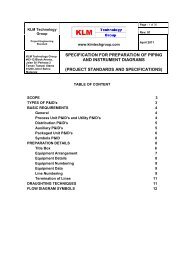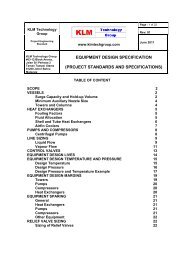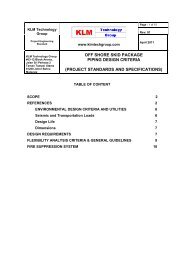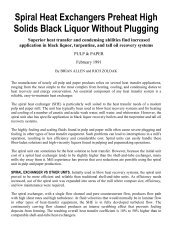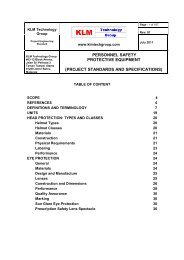30. Engineering Design Guidelines For Furnaces - KLM Technology ...
30. Engineering Design Guidelines For Furnaces - KLM Technology ...
30. Engineering Design Guidelines For Furnaces - KLM Technology ...
- No tags were found...
Create successful ePaper yourself
Turn your PDF publications into a flip-book with our unique Google optimized e-Paper software.
<strong>KLM</strong> <strong>Technology</strong>GroupPractical <strong>Engineering</strong><strong>Guidelines</strong> for Processing PlantSolutionsFURNACE(ENGINEERING DESIGN GUIDELINES)Page 16 of 80Rev: 02May 2012To achieve the lowest possible utility cost, a furnace must operate at maximum efficiency.When a furnace is operated properly, the furnace and its parts have a longer working lifewith minimum repairs. A properly run furnace is a safe furnace. Skillful handing of afurnace means safety for worker.Heat is produce by the ignition of fuel at the burner in the firebox. The tubes along thewall of the firebox are the radiant and the shock bank tubes. These tubes receive radiantheat from the burners. The firebox wall and roof is lined with a material then reduce heatlosses and radiates heat back to the tubes. The entire furnace structure must be air tightfor efficient furnace operation. Air should only enter at designed entries. An air leakreduces the efficiency of the furnace. Below are design considerations for furnace.1. Heaters shall be designed for uniform heat distribution2. Multi-pass heaters shall be designed for hydraulic and thermal symmetry of allpasses. The number of passes shall be minimized. Each pass shall be a singlecircuit3. Average heat flux density in the radiant section is normally based on single row oftubes with two nominal tube diameter spacing.4. The maximum allowable inside film temperature for any process service shall not beexceeded in the radiant, shield, or convection sections.5. minimum radiation loss 2.5 % the total heat input6. Natural draft needs 25% excess air when oil is the primary fuel and 20 % excess airwhen fuel gas is the primary fuel. In case of forced draft operation, 20% Excess airfor fuel oil and 15% Excess air for fuel gas7. Heaters shall be designed such that a negative pressure of at least 0.10 inches ofwater (0.025 kilopascals) is maintained in the radiant and convection sections atmaximum heat release with design excess air.8. The flue gas dew point can be predicted, and the minimum tube-metal temperaturecan be kept high enough to prevent condensation, if the fuel's sulfur content hasbeen correctly stated. (<strong>For</strong> estimated flue gas dew points with respect to sulfurcontent in fuel oil and gas9. In a well-design heater, the radiant-section heat duty should represent more than60% to 70% of the total heat duty10. The bridge wall temperature should range between 800°C to 1,000°C.These design guideline are believed to be as accurate as possible, but are very general and not for specific designcases. They were designed for engineers to do preliminary designs and process specification sheets. The finaldesign must always be guaranteed for the service selected by the manufacturing vendor, but these guidelines willgreatly reduce the amount of up front engineering hours that are required to develop the final design. The guidelinesare a training tool for young engineers or a resource for engineers with experience.This document is entrusted to the recipient personally, but the copyright remains with us. It must not be copied,reproduced or in any way communicated or made accessible to third parties without our written consent.



